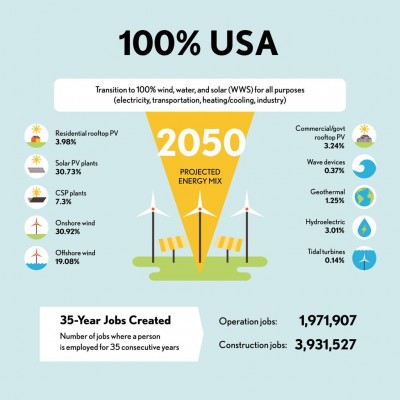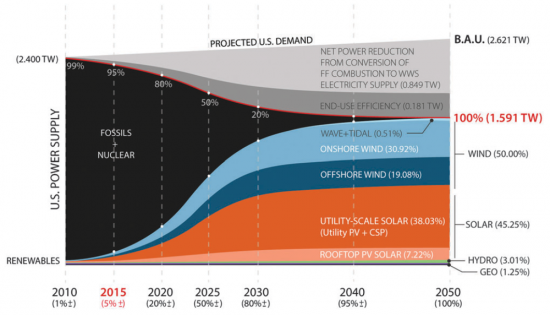December 27, 2015 – Costa Rica has been providing electricity to the country using no fossil fuel sources. The diesel generators are silent as renewable energy takes over. There are no longer any coal-fired thermal energy power plants. Now Costa Rica is a small country blessed with a great solar energy location, and abundant hydroelectric, wind and geothermal capacity. If any country can go 100% renewable it is this one. But what would it take for the United States, currently the second largest greenhouse gas emitter on the planet, to go 100% renewable? Roughly 90 times the size of Costa Rica, the U.S. is also blessed with abundant solar, wind, hydroelectric and geothermal capacity. In addition the U.S. has extensive coastlines, far longer than Costa Rica, where tidal and wave energy can be added to the energy mix.
In a study appearing in Energy & Environmental Science this last spring, researchers at Stanford University and U.C. Berkeley, analyzed how the country could convert energy production, transportation and industry to 80% renewable power by 2030 and 100% by 2050. In the transition net energy demand would be reduced nearly 40% through efficiency built into the distribution of electricity.
The study states that the energy capacity mix needed for 2050 would come from the following sources:
- 31% from onshore wind turbines.
- 19% from offshore wind turbines.
- 31% from utility-produced photovoltaics.
- 7.25% from rooftop photovoltaics.
- 7% from concentrated solar thermal.
- 3% from hydroelectric.
- 1.25% from geothermal sources.
- 0.5% from tidal and wave power.
There would be a significant increase in storage capacity to ensure peak demand and power grid stability. Storage would be integrated within renewable energy facilities.
The conversion from a predominantly fossil-fuel energy mix would produce 3.9 million 40-year construction jobs, and 2 million 40-year operations jobs, outweighing the 3.9 million jobs eliminated by the closing of fossil-fuel and other current energy power plants.
There is no reference in the study to the continued use of nuclear power, or thermal coal with carbon capture, natural gas, and solid biomass. The exclusion of nuclear is interesting because the development of fusion and hybrid fission-fusion power is ongoing in the United States and China, as is the development of thorium-fueled fission reactors. The exclusion of thermal coal, natural gas and biomass, however, does makes sense because the combustion processes in these types of energy sources would still contribute air pollution and life-cycle carbon emissions from them would be highly uncertain.
The conversion to 100% renewable energy will eliminate an average 62,000 premature deaths today that occur annually and are linked to air pollution.
In terms of global warming costs, the elimination of U.S. emissions would mean an overall savings in mitigation and adaptation of approximately $3.3 trillion per year by 2050.
The average American by 2050 will save $260 per year in energy costs and $1,500 per year in health and global climate costs.
The study comes with a road map on how to get to the 100% renewable target for all 50 U.S. states. The roadmaps are based on current ones developed by the states of New York and California.
Extensive tables calculate the energy capacity for all renewable sources state-by-state. For example, the total calculation of wind onshore and offshore capacity before transmission, distribution and energy losses equals 67.8% of anticipated total U.S. energy requirements in 2050. That’s 17.8% higher than the calculated wind-turbine power forecasted as doable by 2050.
In calculating solar power the report studies sun angle, day-night distribution, and cloud coverage across all 50 states projecting residential rooftop capacity alone to equal 660 Gigawatts. By 2050 based on this study only 57% of the total solar potential would be installed.
Some interesting numbers to compare solar capacity with current sources of electricity production. In 2010 conventional hydroelectric capacity amounted to 78 Gigawatts not including power imported from foreign sources (Canada).
Tidal and wave energy generation by 2050 is projected to equal approximately 56.6 Gigawatts. That represents less than half the total capacity which has been calculated at 135.8 Gigawatts just for wave energy alone.
Necessary to make this all work is a revamping of the power grid and the development of a range of storage technologies from battery to pumped storage (air and water) and the use of soil and water as heat sinks.
Achieving 100% energy from renewables biggest benefit will be the health of the population of the country. The estimated cost savings will equal 3.6% of the 2014 U.S. gross domestic product. The investment payback from the conversion in air pollution costs alone is calculated at 20 years.
In calculating the social costs of carbon dioxide from power generation the study uses data on projected global warming damage including these specific categories:
- coastal flooding and real estate damage
- heat stress and strokes from rising temperatures
- the spread of opportunistic diseases including influenza, malaria, dengue and others
- ocean acidification
- drought and wildfire
- severe weather
- air pollution
The timetable for the conversion begins with the following:
- a halt to construction of new coal, nuclear, natural gas or biomass-fired power plants by 2020.
- all new heating, drying, and cooking technologies whether commercial or residential to be powered by electricity by 2020.
- all new ships to be powered by electricity or hydrogen fuel-cells by 2020.
- new rail and bus transport to be electrified by 2025.
- off-road new transport and small-scale marine to be electrified by 2025 to 2030.
- new heavy-duty truck transport to be powered by electricity or hydrogen fuel-cells by 2025 to 2030.
- new light-duty road transport to be powered by electricity by 2030 with national electric-charging infrastructure fully deployed.
- new short-haul aircraft to be powered by electricity or hydrogen fuel-cells by 2035.
- new long-haul aircraft to be powered by electricity combined with hydrogen fuel-cells by 2040.
During the transition the study recognizes that conventional fossil fuels will remain in use.
The study includes policy options including incentive structures to cover in priority sequence:
- energy efficiency
- energy supply
- utility planning
- transportation
- industrial processes
Every state governor and legislature can derive guidance within this paper’s 132 pages. The big question is will they?
And what applies to the United States can be a good starting point for other countries in converting to a zero-carbon future within the 2050 time frame.













